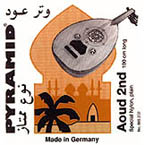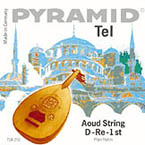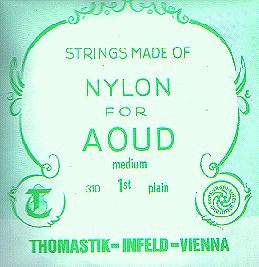
This section will cover a wide explanation about strings in general, but focusing on oud strings. So, it is divided in four sections:
1) String physics: the sound genesis.
2) String frequency: what it depends on.
3) String materials: old and new.
4) Some counsels regarding oud strings.
5) Oud string brands: what to use?
1) String physics: the sound genesis.
String is the first element which initiates the sound produced by any cordophone (any stringed instrument). It consist simply in a long and thin strand of material, put under tension between two fixed points (i.e., nut and bridge). When a string is "activated" through the bare fingers, bow, hammer or so; it starts a vibration which spreads a group of frequencies to the air. One of them will usually predominate above the others, and it is named "fundamental" (= musical note). The other subtle frequencies are named "overtones", and give the timbral properties to the sound.
When a string is tensioned enough, the overtones use to be harmonical, it is, full multiples of the main fundamental tone (2f, 3f, etc). However, instruments like ouds tipically have low tensioned strings (about 30-40 Newtons), which generate also some inharmonic overtones. Far of being noisily, they collaborate in the genesis of the beautiful oud sound!
As you know, strings alone have not a high volume. Instead of that, they do have a high "impedance" (capability of sound transmission to another surface, which will amplify it). To explain this concept, let's take the tuning fork. When activated, its two branches vibrate widely, but having a poor impedance. Being the same piece of metal, they pass and concentrate the energy to the basal prong, which vibrates poorly but getting a high impedance, which allows for instance to transmit and amplify the sound to another surface like a table. Returning to strings, they have high impedance at the bridge point, because it is relatively fixed, then the sound is driven quickly to the bridge, and from there to the soundboard/air chamber/bowl.
The way a cordophone amplifies the string sound is through devices named radiators and resonators. Both soundboard and back bowl are radiators, which amplify the sound in a variable degree, being the soundboard wood quality the most important characteristic (usually spruce). Although both surfaces reflect with a slightly defased wave, and then they partially cancel themselves; it seems not to affect the sound. The air chamber is the instrument's resonator, and the hole characteristic (number, shape, etc) influence in its effectiveness.
Resuming, the most important issues regarding sound are strings and soundboard. Since the last one is chosen by the maker, you only can modify the string topic, trying to choose the best ones which fits your instrument.
| OK...??
|
 |
I know, not so easy... :-) but check out the next section, which gives important concepts.
2) String frequency: what it depends on.
There are four variables which modify the string frequency, it is, the note it will produce when played:
a) lenght: more lenght a string has, lower the note you will get. When a player press a string in the soundboard, what he does is actually shortening the string lenght, so obtaining a higher note.
b) tension: more tension you apply to a string, higher the note you will get. Anyway, you cannot vary the tension too far regarding the intended pitch, because you will get a loose string unable to be played, or on the other hand, a very tensioned string which (if not broken) could detach the bridge or damage the soundboard (or indeed the whole instrument!).
c) thickness: thicker a string is, lower the note it will produce.
d) material: grossly speaking, metal strings sound lower than nylon ones.
Sometimes, these two last variables are joined toghether and considered as "linear density". Anyway, I think it's easier to separate these concepts.
Of course, all these properties interact between themselves to reach the proper tone required. Lenght and thickness are measured in mm, tension in kg or Newtons (1 kg = 9.8 N). About materials, check out the section below. You can wonder how to calculate each of these variables. It can be done easily through some formulas, or better, using string calculator softwares like Arto Wikla's or similars. Putting the known values, you'll get the others.
The easiest way to avoid these complexing tasks: to buy a standard oud string set. Let the manufacturers make the proper calculations!
3) String materials: old and new.
Many different materials were and are used to make strings through time, but the main ones are:
gut: animal intestine, widely used in the past but not now, except when you want to be "authentic" by far. They get broken easily, and detune quickly. Cat, sheep and goat intestines can be used to make them. They must be cut in thin strands and twisted together.
silk: a strength natural material, once very used in Far Eastern instruments (Asian southwest). It's costly. Strings are made by twisting the fibers together.
nylon: it's nowadays the usual replacement for gut and silk strings. Nylon has resistance and strength, but distorts when time passes. There are monofilament strings (like fishing line), or wound strings (nylon over nylon, they are better).
metal: widely used together with previous, they produce a bright and loud sound. They can range from a simple wire to wound metal over nylon strings. Best metal strings are usually made of high-carbon steel, although iron, copper, brass and silver can also be used.
4) Some counsels regarding oud strings.
Frequency of oud string change: it varies regarding how much you play your oud, the brand you chose, etc; but a good period would be every 6 months.
3rd course, nylon or wire wound?: Arabic sets comes many times in two versions regarding high D course, nylon or metal. I find nylon 3rds too thick to be played properly, so I always prefer to use wire wound for it. Anyway I guess advanced players can use anyone of them, I'm just an amateur player... :-)
1st and 2nd course, plain or wire wound nylon?: unfortunately, most sets I know the two or three high courses are made of plain nylon. Sometimes they are good, but I largely prefer to use wire wound nylon, they are much more loud sounding and playable.
5) Oud string brands: what to use?
Pyramid The German makers of almost all kinds of strings. They have many sets of different quality (and price), from "yellow", "red", "orange" and "super" (best) sets. Also they have a Turkish set which I will not test since they develop a higher tension that my Arabic oud cannot handle. I tested two of these sets until now.
> yellow set (652200): it's good if you can't get proper oud strings, but not the best in my opinion. Good basses, but the main problem is the very thick 3rd (high D) string made of nylon monofilament which difficults a proper motion. They detune easily, at least in a humid environment like my city is. It has a variant with 3rd metal wound (652000 which I didn't tested yet).
 |
> orange set (650000): this is a very good
string set, which projects a clear a brilliant sound. It improved
drastically my oud sound for better. This set has a tension varying
between 35-40 Newtons, maybe slightly higher than conventional tension,
which could partly explain the nice sounding. It has the 3rd (high D)
metal wound. They stay tuned quickly.
I used this set by almost a whole year without problems. |
 |
> "super" oud set (665200): I started to test this set recently, and I must say it's excellent. Loud and bright sound, it stays tuned easily. Slightly more metallic sound regarding orange set, I find it as good as this, maybe better. It has also the 3rd (high D) metal wound. |
 |
> Turkish set: the only set for Turkish ouds by Pyramid. They are prepared for higher tensions (between 30 and 67 Newtons). Never try to put a Turkish set in an Arabic oud, you could damage your instrument! |
Thomastik The renowned Austrian string brand also makes two sets intended for ouds, labeled 315 and 315a:
 |
> 315 set: good high courses (three upper ones)
made of plain nylon, excellent basses made of wire wound. > 315a set: the same of 315, but with 3rd. course wire wound instead of nylon (recommended). I tried this set for a whole year, I'd say it kept in a perfect shape by about 10 months. |
Kürschner Also German made. I didn't get envelopes and I coudn't test them, but I understand they are of very good quality.
LaBella Strings made in USA, more used by American players. They have two sets, named OU80 (Turkish or Armenian tunings) and OU80A (intended for Arabic tuning). I tested the Arabic set. Its sound is somewhat darker (less methalic) than the other brands, and maybe it is more "authentic" as an oud should be, but also it's not so loud regarding the other ones. They stay in tune easily. A very good brand.
D'Addario Strings also made in USA. I had severe problems deciding whether putting or not this set in my Arabic oud, since it seems to be intended to a rare (at least for me) tuning. They supposedly develop higher tension than recommended for an Arabic oud integrity, although in the oudlist some people use them successfully. I made the try, and I found especially 3rd and 5th (from high to bass, so d and G notes) too tensioned to be comfortable with playing and of course with my oud health. So I retired them after a couple of days. I had no answer from D'Addario regarding this tension problem, just a link to a tension table which didn't show oud strings. So, it goes for your own risk! although I guess you could try them in a Turkish oud? don't know actually.
More data shown below:
 |
> J95 set: it comes with 6 courses, unlike the other brands which generally comes with 5 courses. They are originally intended for F#BEadg tuning from bass to high, but developing tensions between 47 and 84 Newtons (too high!). |
* * * * *